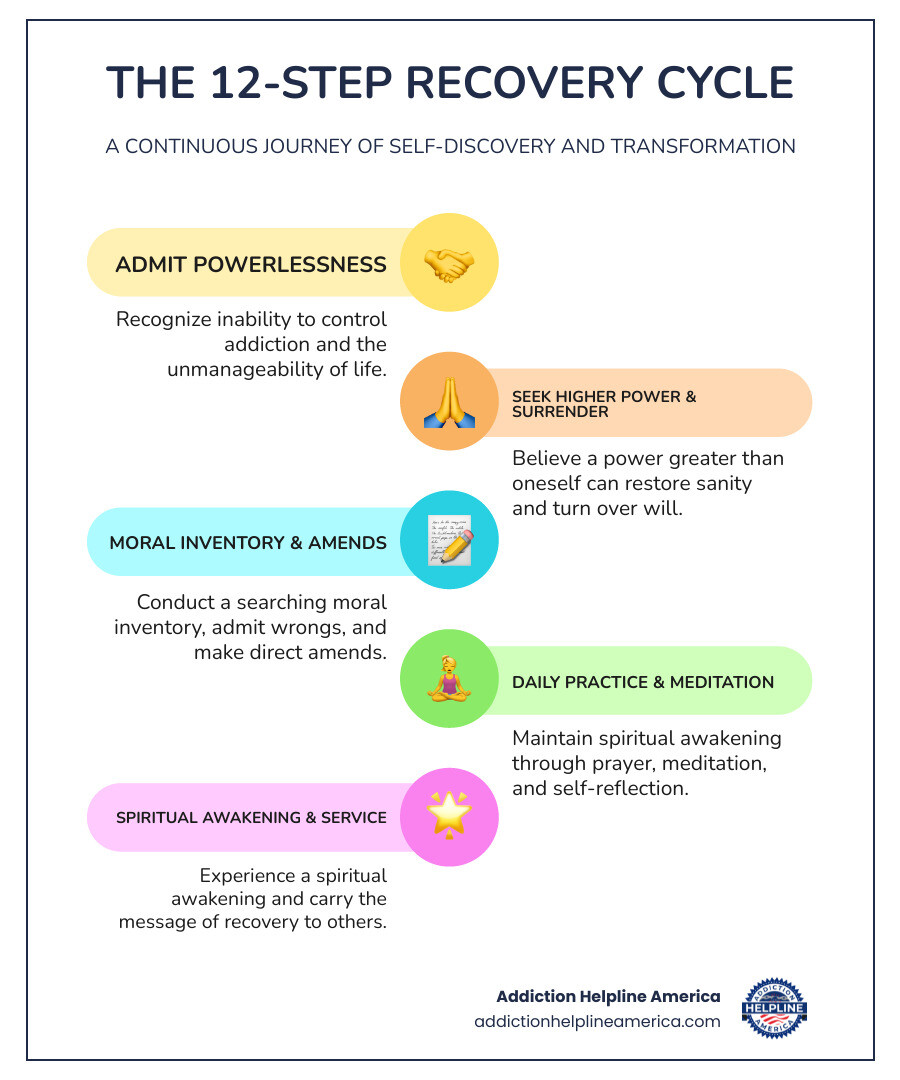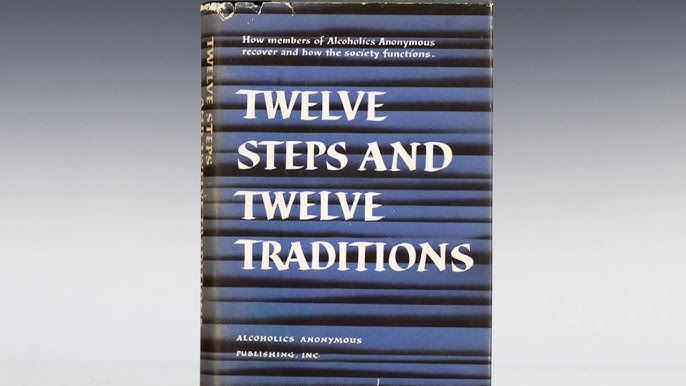Your Journey to a Healthier Life Starts Here
Free Insurance Verification
Verify Your Treatment Coverage
Verify Your Treatment Coverage
A 12 Step Program is a peer-led approach to overcoming addiction and compulsive behaviors, first developed by Alcoholics Anonymous in the 1930s. It guides participants through 12 steps focused on admitting powerlessness, seeking support from a higher power (as individually understood), making amends, and helping others. Today, these programs are used by nearly 50% of treatment centers nationwide for a wide range of addictions.
Key Facts About 12-Step Programs:
Many participants describe their first meeting as feeling like they were “coming home”—no longer alone in their struggle. The journey through addiction affects millions, and understanding how 12-step programs work can be a vital part of finding a path forward.
At Addiction Helpline America, we guide individuals and families through their recovery options, connecting them with appropriate 12-Step Programs and other treatment resources. Our team is here to help you find the support that fits your unique needs.

A 12 Step Program is a framework for personal change built on honesty, self-reflection, and mutual support. It’s not a quick fix but a journey guided by the principle that willpower alone is not enough to overcome addiction. Recovery begins by acknowledging powerlessness, seeking help from a higher power, and leaning on a community of peers who understand the struggle.
The model began in 1935 when Bill Wilson, a stockbroker, and Dr. Bob Smith, a surgeon, found they could stay sober by sharing their experiences with each other. At the time, addiction was seen as a moral failing, but they recognized that one alcoholic helping another was uniquely powerful. From spiritual principles from the Oxford Group, they created a practical program focused on peer support and personal change.
Their ideas were published in 1939 in “The Big Book” of Alcoholics Anonymous, which introduced the disease model of addiction. This text described alcoholism as a condition with physical, mental, and spiritual dimensions, not just a lack of willpower. From this humble start, Alcoholics Anonymous grew into a worldwide movement that serves as a blueprint for hundreds of other fellowships. You can learn more at The history of Alcoholics Anonymous.
The philosophy of a 12 Step Program centers on several key principles:
The guiding mantra is “one day at a time,” which makes the overwhelming goal of lifelong sobriety manageable by focusing only on today.
A 12 Step Program is built on two frameworks: the Twelve Steps, which guide personal recovery, and the Twelve Traditions, which ensure the group remains a healthy and safe space. The Steps are the personal roadmap to healing, while the Traditions are the guardrails that keep the community focused and unified.


Take the first step towards a healthier life! Call now to connect with our compassionate team and start your recovery journey today. Your path to healing awaits!
Our recovery specialists are available 24/7 to provide support, and all calls are confidential and free. Reach out anytime – we’re here to help!
The Twelve Steps are the heart of the program, providing an actionable path to recovery. Though the wording may vary slightly between fellowships, they guide participants through a transformative process:
Working the steps is a process of deep personal change, moving from admission and surrender to action and service.
While the Steps focus on individual recovery, the Twelve Traditions focus on group unity and survival. They are the principles that ensure the fellowship remains healthy and available for all who need it. Key traditions include:
The Steps teach individuals how to recover, while the Traditions teach groups how to function so they can continue to help others.
Understanding the principles is one thing, but what does a 12 Step Program look like in daily life? It revolves around regular meetings, honest sharing, and personal relationships.
Meetings are the cornerstone of the program. Typically lasting 60-90 minutes, they provide a safe and supportive environment. Most follow a simple format:
There are open meetings for anyone to attend and closed meetings exclusively for those with a desire to stop their addictive behavior.
Two concepts are central to working the program: a Higher Power and sponsorship.
The term “God as we understood Him” is intentionally open-ended, making the program spiritual, not religious. Your Higher Power can be anything that makes sense to you: a traditional God, the collective wisdom of the group, nature, or the universe. Agnostics and atheists are welcome and find recovery by defining a power greater than their own addiction.

Sponsorship is a vital part of recovery. A sponsor is a member with more experience who guides you through the Twelve Steps. They are not a therapist but a mentor who shares their own journey and offers support. This relationship is built on trust and mutual respect. You can find more Information on sponsorship in AA’s official resources.
There is no set timeline. A 12 Step Program is a lifelong journey of growth, not a checklist to be completed. Some people work through the steps in a few months, while others take a year or more. The focus is on thoroughness and honesty, not speed.
Many newcomers are encouraged to attend “90 meetings in 90 days” to build a strong foundation and connect with the community. Even members with decades of sobriety continue to work the steps, using them as a toolkit for living. The goal is progress, not perfection, one day at a time.
While the 12 Step Program has helped millions, it’s important to understand its effectiveness, limitations, and how it compares to other recovery options.
Evidence for the effectiveness of 12-step programs is strong. A landmark 2020 Cochrane review on Alcoholics Anonymous found that AA participation often leads to higher rates of continuous abstinence compared to other treatments like CBT. According to SAMHSA, nearly half of U.S. treatment centers incorporate 12-step models.
Beyond abstinence, active participation is linked to improved psychosocial functioning, better relationships, and increased self-confidence. Research also shows that consistent attendance, especially when started during professional treatment, leads to better long-term outcomes.
Despite its success, the 12-step model isn’t for everyone. Common criticisms include:
These limitations are important to consider when choosing a recovery path.
If a 12 Step Program isn’t the right fit, several evidence-based alternatives are available:
At Addiction Helpline America, we can help you explore these different approaches to find what works best for you.
The reach of the 12 Step Program extends far beyond substance use. The core principles are so adaptable that they now apply to dozens of compulsive behaviors, from gambling to overeating to codependency. While programs for alcohol and drug addiction are the largest, the majority of 12-step fellowships address behavioral issues.
| Program | Primary Focus | Primary Purpose |
|---|---|---|
| Alcoholics Anonymous (AA) | Alcohol addiction | To stay sober and help other alcoholics achieve sobriety |
| Narcotics Anonymous (NA) | Drug addiction (all substances) | To carry the message to the addict who still suffers |
| Al-Anon/Alateen | Family members and friends affected by someone else’s drinking | To help families recover from the effects of living with alcoholism |
The genius of the model is its flexibility. The language and focus of the steps are modified to address the specific issue, while the core principles remain the same. Examples include:
Other fellowships include Codependents Anonymous (CoDA), Debtors Anonymous (DA), and Sex Addicts Anonymous (SAA), ensuring a supportive community exists for nearly any compulsive behavior.
While these programs can help anyone, they tend to be most effective for individuals who:
12-step programs are an excellent complement to professional treatment and are particularly helpful for those with co-occurring disorders, who may also find support in specialized groups like Dual Recovery Anonymous. The best way to know if it’s right for you is to attend a few meetings. Most people suggest trying at least six different meetings to find a group that feels like a good fit.

Take the first step towards a healthier life! Call now to connect with our compassionate team and start your recovery journey today. Your path to healing awaits!
Our recovery specialists are available 24/7 to provide support, and all calls are confidential and free. Reach out anytime – we’re here to help!
Here are answers to some of the most common questions about 12 Step Programs.
No. This is a common misconception. The program is spiritual, not religious. The phrase “God, as we understood Him” means the concept of a “Higher Power” is open to personal interpretation. For many, this power is the group itself, nature, or a set of guiding principles. People of all beliefs, including atheists and agnostics, are welcome and find success in the program.
Yes, 12 Step Program meetings are completely free. There are no dues or fees for membership. The groups are self-supporting through voluntary donations from members, who contribute what they can to cover expenses like rent and coffee. No one is ever required to donate or turned away for not contributing.
Understanding this distinction helps you find the right meeting for your needs.
Both meeting types are valuable, but closed meetings are often the best starting point for those seeking personal recovery.
Learning about recovery options like the 12 Step Program is a courageous first step. These programs offer hope, structure, and a powerful community, changing millions of lives by providing a framework for a meaningful, sober life.
However, recovery is not one-size-fits-all. The most effective plan is often a holistic one that addresses your unique needs. This might mean combining a 12 Step Program with professional therapy, medication-assisted treatment, or another approach like SMART Recovery. There is no single “right” way to recover; the goal is to find what works for you.
Navigating these options can feel overwhelming, but you don’t have to do it alone. At Addiction Helpline America, we provide free, confidential, and personalized guidance. Our team listens to your story without judgment and helps you understand your choices. We connect you with resources from our vast network of treatment centers and support groups that are the right fit for your circumstances and goals.
Your long-term wellness is our priority. Whether you’re looking for a 12 Step Program, exploring alternatives, or seeking comprehensive treatment, we are here to help you build your personalized path to recovery. One conversation can make all the difference.
Reach out today to Find a personalized addiction treatment program. We’re ready to guide you toward the recovery you deserve.
Are you or a loved one struggling with addiction? Call today to speak to a treatment expert.
Calls to any general helpline will be answered or returned by one of the treatment providers listed, each of which is a paid advertiser:
Our helpline is available 24 hours a day, 7 days a week at no cost to you and with no obligation for you to enter into treatment. We are committed to providing support and guidance whenever you need it.
In some cases, Addiction Helpline America charges our verified partner a modest cost per call. This fee helps us cover the costs of building and maintaining our website, ensuring that we can continue to offer this valuable service to those in need.
Calls to the general helpline will be answered or returned by one of the listed treatment providers, all of whom are paid advertisers.
By using the helpline, you agree to the terms of use. We do not earn any commission or fee based on the treatment provider selected by the caller, and there is no obligation to pursue treatment.
This service is not affiliated with Alcoholics Anonymous World Services, Inc.